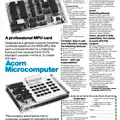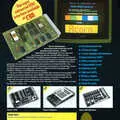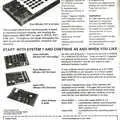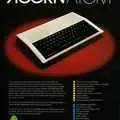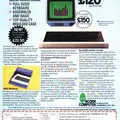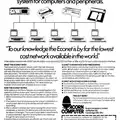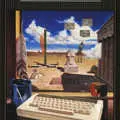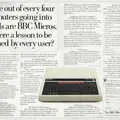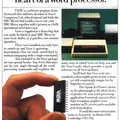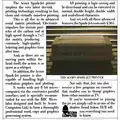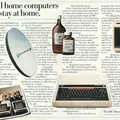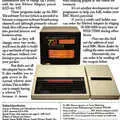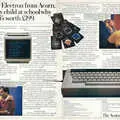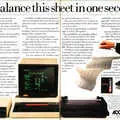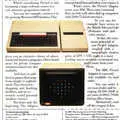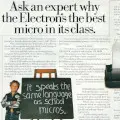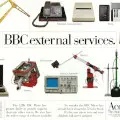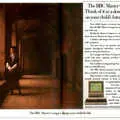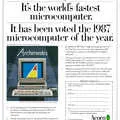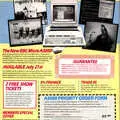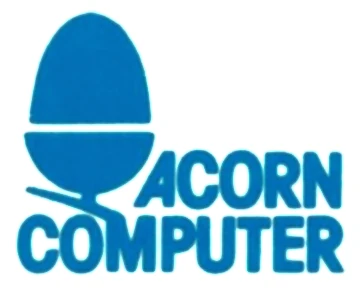
Acorn Advert - September 1984
From The Micro User
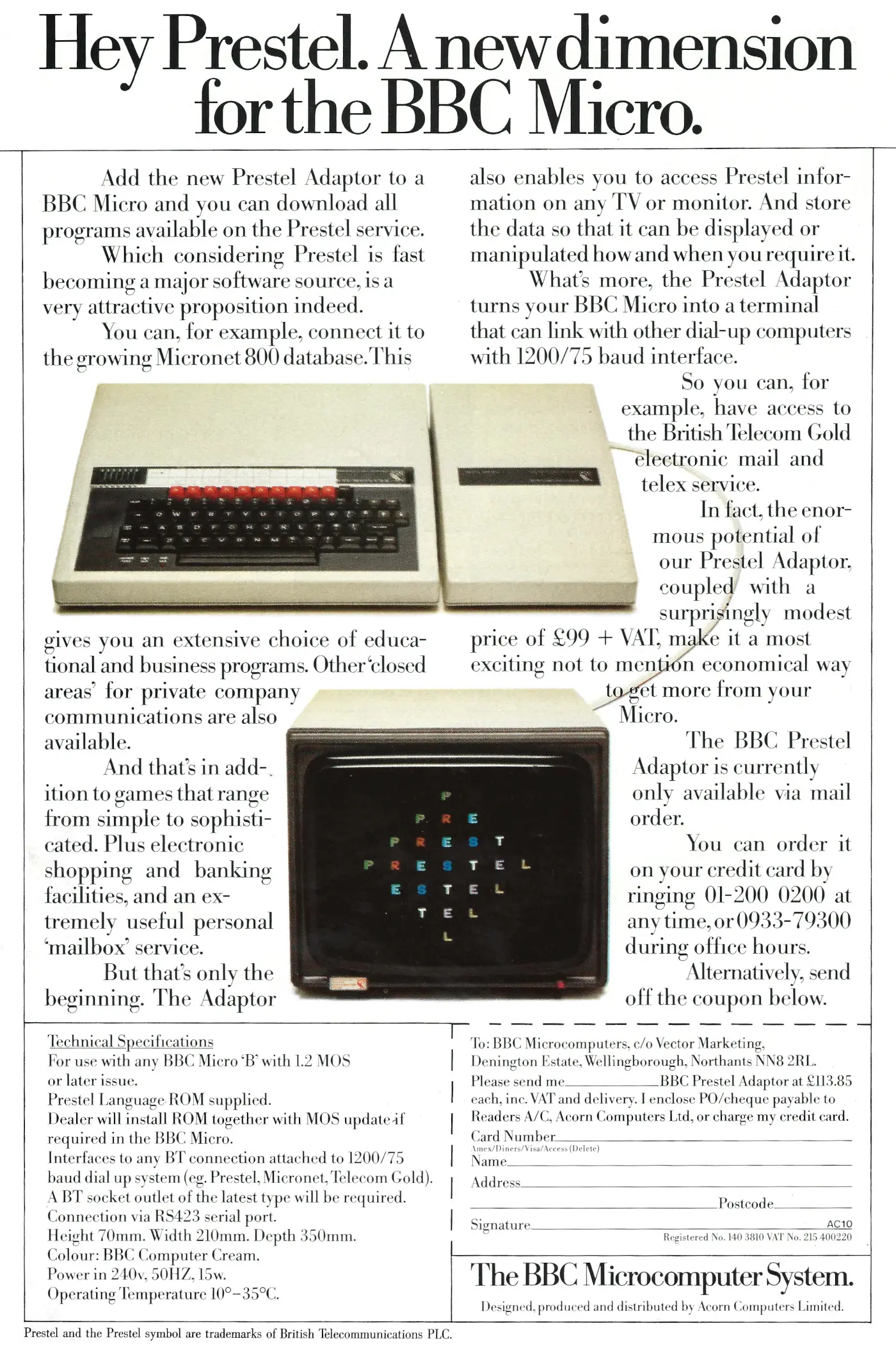
Hey Prestel. A new dimension for the BBC Micro
Here's another advert that shows that the world of 'on-line' was alive and well long before the advent of the Internet.
Prestel was a UK electronic information system set up by the General Post Office (GPO) and then run by the post-privatisation BT.
It was fundamentally a dial-up version of Teletext, although the first iteration was targetted at Prestel-enabled televisions rather than computers.
Prestel was launched in September 1979, following the first demonstration of a working "Prestel television" by ITT Consumer around the beginning of 1978[1].
It was subscription only, and wasn't cheap on account of monthly charges, dial-up-per-minute costs and even pay-per-view charges for some content thrown in too.
On the upside, once subscribed, it was possible to download sometimes-free software with a suitably-equipped computer, hence this adapter for the BBC Micro.
The birth of Viewdata and Prestel
The idea for the Viewdata system had first been mooted in 1968 by Sam Fedida of the GPO's research centre.
Its first version, with 300 pages of information - in monochrome and in upper-case only - was running on an HP 2100 by 1973, with further demonstrations during that and the following year.
In 1974 the related viewdata service Teletext first appeared, with both the BBC and IBA launching services - Ceefax and Oracle respectively.
The GPO had originally wanted to call its service "Viewdata" but the trademark was rejected as the name was thought to be both too technologically-specific and too broad, so its official name became the Prestel viewdata service.
Teletext differed from true Viewdata as it was non interactive, however the two were close enough that they were both covered by a joint standard published at the beginning of 1976.
The first public demonstration of Prestel occured at Eurocomp in 1975, after which a wider market trial was launched with 1,500 users in London, Birmingham and Norfolk.
After problems in recruiting 1,500 users, this trial was turned into an official "test service", after which followed the "London Residential Service" which started in the spring of 1979. The national roll-out followed in the September of the same year.
The service, as of the end of 1979, provided around 250,000 "frames" of information stored in its Viewdatabase, compared to Teletext's 100 or so.
Teletext's restriction was necessary to limit the time taken to broadcast an entire set of pages - one frame took 0.25 seconds, so the entire set of 100 frames could be received in around 12 seconds[2].
The Post Office managed to sell Prestel's technology abroad, with Hong Kong, Switzerland and the Netherlands being amongst countries that adopted systems very similar to Prestel. It had also been in talks with AT&T of the US, to see how Viewdata could be connected to the American phone system[3].
Elsewhere, there were several alternatives such as Canada's Telidon - a name uncomfortably close to that peculiarly-1990s obsession of teledildonics - which instead of treating data as a linear sequence of characters used Picture Description Instructions, presumably making it a bit like Postscript.
Telidon was demonstrated in the UK at the Viewdata 80 exhibition held at the Wembley Conference Centre between the 26th and the 28th of March, 1980.
There was also Antiope, as used in France, which was more expensive to implement but was more flexible as it used a more descriptive 16-bit data format generated by the receiver, with the transmitted data only using 8 bits.
This format was used for France's famous Minitel terminals, which ran on the Télétel system. Unlike Prestel, Antiope supported "zero width" control characters which didn't occupy a space on the screen - a necessity in order to support the various diacritics and accents required for the French language.
Much like how Europe's vastly superior 652-line PAL/SECAM television standard improved over the US' NTSC by not being first, it was said that "the boot might be on the other foot when it came to Prestel"[4].
Prestel did attempt to address the problem of higher-resolution graphics, at least compared to its usual "alphamosaics" when, also at Viewdata 80, it announced "Picture Prestel", a new format which allowed a compressed "photo" to occupy up to one-eight of the screen, however it wasn't expected that Picture Prestel would be available until the end of the decade[5].
Meanwhile, a couple of years later in 1991, Minitel got a significant upgrade to its system, which by then provided services like Directory Enquiries, on-line shopping and adult chat lines, known as services rose.
Previously, Télétel had run on V.23 1200/75 baud lines favoured by other Videotex systems, not least Prestel.
This relatively low speed had restricted the use of higher-resolution graphics, so to address this France Télécom had been running tests at 4800bps, which it was expecting to launch publicly in the autumn of '91, as well as 9600bps, although no date had been fixed for that[6].
Even so, the 4800bps system - called Minitels Photo, and which was initially aimed at business wishing to do point-of-sale presentations - would still take eight seconds to show a half-screen-sized scanned photo.
Minitel was unusual in that the display terminals were provided as part of the subscription, and so it was expected it would take years to upgrade the entire network. Nevertheless, France Télécom was already looking beyond that to a point when Minitel could be merged with the 64kbps Numéris network - France's equivalent of the UK's ISDN.
Get orrf our network
In Prestel's early days it had been staggeringly difficult to even think about connecting a computer to the public phone system, as the systems owner - the General Post Office, or GPO - had all sorts of arcane rules and lots of paranoia about what could be attached to its network.
That mostly meant nothing unless it was a acoustic-coupler modem, whilst anything else out of the ordinary required personal written approval from the regional sales office[7].
By the spring of 1984, the government had received so much criticism about the matter that it announced a quicker approval procedure for modems and "other attachments to the telephone system".
The upshot of the scheme was that manufacturers could self-certify after passing a basic safety test and get interim approval to allow them to start selling their equipment.
The downside was that they also had to provide insurance to protect their users in case the device didn't ultimately get full approval, or if they had to undertake modifications to their already-sold devices in order to get them to comply with the standards, all of which could potentially add to the costs[8].
This impact of this extra cost was a potential worry as modems were only just reaching sensible levels of affordability - Answercall's 300/300 modem was selling for only £75 (£310) in May of 1984.
In 1982, the results of an educational trial involving Prestel was published by the Council for Educational Technology.
The study showed that access to Prestel was something of "an incentive to class work" and that:
"it helped to encourage advanced reading skills, skimming and scanning, and there were some indications that, in the case of slower readers, the motivation of using Prestel and the need to understand the options presented on a frame were an incentive to the development of reading".
There were also some criticisms, primarily that the infomation available was mostly focussed on economics, business studies, geography and social studies[9].
Prestel all at sea
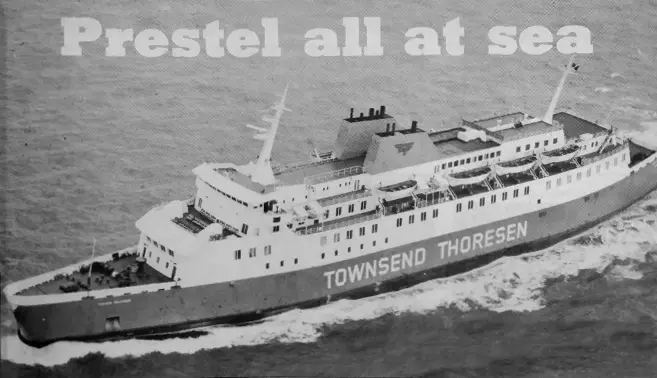
The Townsend-Thoresen Felixstowe to Zeebrugge ferry, Viking Voyager, featuring Prestel. © Practical Computing June 1982In the same year, the world's first viewdata system for use by ships at sea was launched.
Called SeaView, the system was developed by systems house CAP in association with the Department of Industry, British Telecom, Liverpool Polytechnic and Siemens.
Two SeaView terminals were installed at CAP's Reading offices whilst a third was based on Southampton-based cable ship, CS Alert.
The ship system offered access to Finnish and Hong Kong viewdata systems as well as Prestel, and came with the added bonus of two-way communications between the ship and land, thanks to the Inmarsat geostationary satellite[10].
Following the trial on the Alert, the system was rapidly upgraded to a more commercial prototype on the glamorous Felixstowe to Zeebrugge North Sea ferry crossing, not unlike that unforgettably featured in the BBC's ill-fated and very grey soap opera, Triangle[11].
The set up, on the Townsend Thoresen car ferry Viking Voyager, involved a VHF radio link to the shore-based Prestel, running over at least one of the ship's regular radio-telephone channels.
These in turn connected to one of British Telecom's 11 manned and 19 un-manned radio-telephone base stations dotted around the coast of the UK and could operate at up to 24 miles out to sea.
Beyond that, the system would use backed-up pages saved to tape or disc.
Funding for the sea trial - at around £325,000, or £1,559,600 in 2025, came largely from the Department of Industry, along with CAP and Siemens, which had been behind the earlier CS Alert tests.
It was demonstrated by the Under-Secretary for State John Wakeham, who suggested that it was "very much in keeping with the spirit of IT Year '82", the Government scheme from which the money came.
Wakeham went on to suggest a future where ships all over the world could connect up to Prestel via satellite, and indeed Prestel's international gateways already allowed connection on to the German and Finnish Viewdata networks - handy in the North Sea region.
Townsend Thoresen's interest in the service, meanwhile, was far more practical - partly because it was keen to keep itself at the fore-front of sea-borne technology but also because it could also use the data connections to automatically call ahead for stock to replenish its duty free shops and bars, where most of its profits were made but which took most of the time to sort out whilst in port.
There was also the opportunity for the public to book hotels at their destination whilst on board, or for drivers to get near real-time updates on traffic conditions before docking[12].
Prestel: end of the line?
Prestel always struggled to gain real market traction, and by the early summer of 1982 there were already rumours - reported in Practical Computing - that it might shut up shop[13].
It wasn't the end of the line, at least not yet, but even by the autumn of that year there were only 20,000 people connected to the service, despite its 250,000 pages of information.
The Government minister in charge of all things "videotex", which included broadcast teletext as well as Prestel, was Kenneth Baker, the man who had launched the schemes which had put a micro into 30,000 primary and secondary schools in the UK.
Commenting in a January 1982 interview for Your Computer on how much the uptake of Prestel had fallen behind BT's forecasts, Baker said:
"I think Prestel has been slow because British Telecom went for the domestic market, and the domestic consumer is, quite justifiably, worried about the extra cost. I can see why BT wanted to go for that market. There are many unused telephone lines outside business hours".

Kenneth Baker, Minister for Information Technology, © Your Computer, January 1982Baker went on to compare the simplicity (and cheapness, on account of being effectively free) of teletext, which had been the focus of "The Teletext Month" in October of the previous year, with Prestel's daunting costs and active use of a phone line.
By the end of 1981, 20% of all TVs being sold were teletext-capable, and Baker hoped that by the end of 1982 there would be up to a million teletext TVs.
The more there were, the more people became familiar with on-screen information - a "breakthrough in familiarisation" as he put it. Prestel, on the other hand was taking much longer to get off the ground:
"As far as the consumer is concerned, teletext is just another button on the television set. If you have Prestel it is telephone time you are using and most people reckon that is expensive, which it is"[14].
It was also suggested that Prestel suffered from various "user experience" problems, not least of which was the fact that it was nigh-on impossible to remember any route through the system as it was changing all the time.
Practical Computing compared it to playing an Adventure game, or more colourfully to the "blind man feeling an elephant", and posited that it compared badly to other sources of information, like newspapers, which were consistent in their presentation and which had built up a level of trust that their information was up to date.
Prestel lacked this trust because not enough people relied on the information, so you couldn't be sure it was accurate, whilst the print media and their channels of distribution "had become woven over the course of time into a dense and satisfactory mat"[15].
As an aside, the same article referred to news of the announcement that the government was "vigorously [intending] to rewire the country with optical fibre".
Sadly, this just about sums up the government's record on telecoms infrastucture investment, as many UK villages were only just getting their first fibre broadband cabinets by the early 2020s, some 38 years later or more, whilst widespread fibre to the premises is still several years away.
In order to try and boost membership, Prestel launched the cryptically-named "Project Y" - a plan to give away 100,000 Prestel adapters to customers of a mystery financial institution, believed to be a Building Society.
Approved by the Board of BT in October, the idea was the result of a government-backed conference held back in February.
It was hoped that some 2,000 adapters - for televisions, rather than micros, although including a full alpha-numeric keyboard - would be installed per month[16].
In an era of increasingly-cheap modems, devices like the sort of custom adapter featured in this advert could be a bit of a cul-de-sac, as these were frequently just for Prestel, with its 1200/75 baud rates and specific viewdata protocol.
Still, at least this Prestel adapter was fairly affordable at around £115 (£480 in 2025), a price which compared well to an early Prestel adapter released for the Apple II just four years previously in 1980.
The Appletel, made by Owl Computers, weighed in at £595, or £3,770 in 2025, a price which didn't even include the modem.
Of course that didn't really matter too much, because the only modems available at the time, or even allowed onto the phone network, were the Post Office's own[17].
Date created: 01 July 2012
Last updated: 03 September 2025
Hint: use left and right cursor keys to navigate between adverts.
Sources
Text and otherwise-uncredited photos © nosher.net 2025. Dollar/GBP conversions, where used, assume $1.50 to £1. "Now" prices are calculated dynamically using average RPI per year.
